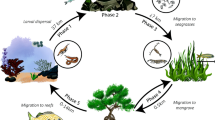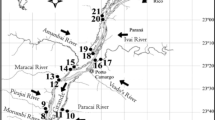Abstract
The disruption of longitudinal connectivity caused by artificial barriers in rivers is considered to be a major threat to freshwater fish communities at the global scale. In Portugal, the construction of several big dams all through the 20th century was a major cause of disappearance or decline of long distance migratory fish species from various rivers. In this study we analysed the historical changes of functional connectivity for diadromous fish at the Tagus basin river network (Portugal), using a spatial graph approach that integrates both structural connectivity and habitat suitability. Due to the presence of many artificial barriers, the current distribution of species does not reflect natural environmental conditions. Therefore, historical data on the occurrence of species is paramount to assess the potential habitat suitability. The compilation of historical data on the distribution of diadromous species [Sea Lamprey—Petromyzon marinus (Linnaeus 1758) and Allis shad—Alosa alosa (Linnaeus 1758)] was based on geographical dictionaries and geo-referenced information for Portugal dated between 1700 and 1900. Habitat suitability was expressed as the probabilities of occurrence of empirical predictive models based on the historical records and a set of regionalized environmental data. The loss of connectivity caused by big dam construction between 1928 and 2004 was then analysed using a spatial graph approach. The output of this analysis will aid decision-makers to optimize targets of connectivity restoration actions aiming at enhancing the functional connectivity of the river network for diadromous species, using the historical situation as a benchmark.







Similar content being viewed by others
References
Acolas ML, Bégout Anras ML, Véron V, Jourdan H, Sabatie MR, Bagliniére JL (2004) An assessment of the upstream migration and reproductive behaviour of allis shad (Alosa alosa L.) using acoustic tracking. ICES J Mar Sci 61:1291–1304
Almeida PR, Quintella BR, Dias NM, Andrade N (2002) The anadromous sea lamprey in Portugal: biology and conservation perspectives. In: Moser M, Bayer I, MacKinlay D (eds) The biology of lampreys, symposium proceedings. American Fishery Society, Vancouver
Almeida PR, Tomaz G, Andrade NO, Quintella BR (2008) Morphological analysis of geographic variation of sea lamprey ammocoetes in Portuguese river basins. Hydrobiologia 602:47–59
Almodóvar A, Nicola GG (1999) Effects of a small hydropower station upon brown trout Salmo trutta L. in the river Hoz Seca (Tagus basin, Spain) 1 year after regulation. Regul River 15:477–484
Baranyi G, Saura S, Podani J, Jordán F (2011) Contribution of habitat patches to network connectivity: redundancy and uniqueness of topological indices. Ecol Indic 11:1301–1310
Béguer M, Beaulaton L, Rochard E (2007) Distribution and richness of diadromous fish assemblages in Western Europe: large-scale explanatory factors. Ecol Freshw Fish 16:221–237
Branco P, Segurado P, Santos JM, Pinheiro P, Ferreira MT (2012) Does longitudinal connectivity loss affect the distribution of freshwater fish? Ecol Eng 48:70–78
Branco P, Segurado P, Santos JM, Ferreira MT (2014) Prioritizing barrier removal to improve functional connectivity of rivers. J Appl Ecol. doi:10.1111/1365-2664.12317
Brown LR, Ford T (2002) Effects of flow on the fish communities of a regulated California river: implications for managing native fishes. River Res Appl 18:331–342
Cabral MJ, Almeida J, Almeida PR, Dellinger T et al (eds) (2005) Livro vermelho dos vertebrados de Portugal. Instituto de Conservação da Natureza, Lisbon
Calabrese JM, Fagan WF (2004) A comparison shoppers’ guide to connectivity metrics: trading off between data requirements and information content. Front Ecol Environ 2:529–536
Cote D, Kehler DG, Bourne C, Wiersma YF (2010) A new measure of longitudinal connectivity for stream networks. Landsc Ecol 24:101–113
Doadrio I, Elvira B, Bernat Y (1991) Peces continentales españoles. Ministerio de Agriculturva, Pesca y Alimentación. ICONA. Colección técnica. Madrid, Inventario y clasificación de zonas fluviales
Elith J, Leathwick JR, Hastie T (2008) A working guide to boosted regression trees. J Anim Ecol 77:802–813
Erös T, Olden JD, Schick RS, Schmera D, Fortin M-J (2012) Characterizing connectivity relationships in freshwaters using patch-based graphs. Landsc Ecol 27:303–317
Erős T, Schmera D, Schick RS (2011) Network thinking in riverscape conservation–a graph-based approach. Biol Conserv 144:184–192
Fagan WF (2002) Connectivity, fragmentation, and extinction risk in dendritic metapopulations. Ecology 83:3243–3249
Fausch KD, Torgersen CE, Baxter CV, Li HW (2002) Landscapes to riverscapes: bridging the gap between research and conservation of stream fishes. Bioscience 52:483–498
Fielding AH, Bell JF (1997) A review of methods for the assessment of prediction errors in conservation presence/absence models. Environ Conserv 24:38–49
Friedman JH (2001) Greedy function approximation: a gradient boosting machine. Ann Stat 29:1189–1232
Fullerton AH, Burnett KM, Steel EA, Flicroft RL, Pess GR, Feist BE, Torgersen CE, Miller DJ, Sanderson BL (2010) Hydrological connectivity for riverine fish: measurement challenges and research opportunities. Freshw Biol 55:2215–2237
Guisan A, Zimmermann NE (2000) Predictive habitat distribution models in ecology. Ecol Model 135:147–186
Hall CJ, Jordaan A, Frisk MG (2010) The historic influence of dams on diadromous fish habitat with a focus on river herring and hydrologic longitudinal connectivity. Landscape Ecol 26:95–107
Heller NE, Zavaleta ES (2009) Biodiversity management in the face of climate change: a review of 22 years of recommendations. Biol Conserv 142:14–32
Hijmans RJ, Phillips S, Leathwick J, Elith J (2013) Species distribution modeling. Package “dismo”. http://cran.rproject.org/web/packages/dismo/dismo.pdf. Accessed 20 Sept 2013
Hodgson JA, Thomas CD, Wintle BA, Moilanen A (2009) Climate change, connectivity and conservation decision making: back to basics. J Appl Ecol 46:964–969
Humphries PL, Winemiller KO (2009) Historical impacts on river fauna, shifting baselines and challenges for restoration. Bioscience 59:673–684
INAG I.P. (2001) Plano de Bacia Hidrográfica do Rio Tejo - Relatório Final. Lisbon
Laita A, Kotiaho JS, Mönkkönen M (2011) Graph-theoretic connectivity measures: what do they tell us about connectivity? Landscape Ecol 26:951–967
Lassalle G, Béguer M, Beaulaton L, Rochard E (2008) Diadromous fish conservation plans need to consider global warming issues: an approach using biogeographical models. Biol Conserv 141:1105–1118
Lassalle G, Crouzet P, Rochard E (2009) Modelling the current distribution of European diadromous fishes: an approach integrating regional anthropogenic pressures. Freshw Biol 54:587–606
Limburg KE, Waldman JR (2009) Dramatic declines in North Atlantic diadromous fishes. Bioscience 59:955–965
Lucas MC, Baras E (2001) Migration of freshwater fishes. Blackwell Science, Malden
Luterbacher J, Dietrich D, Xoplaky E, Grosjean M, Wanner H (2004) European seasonal and annual temperature variability, trends, and extremes since 1500. Science 303:1499–1503
Mateus CS, Rodríguez-Muñoz R, Quintella BR, Alves MJ, Almeida PR (2012) Lampreys of the Iberian Peninsula: distribution, population status and conservation. Endanger Species Res 16:183–198
McKay SK, Schramski JR, Conyngham JN, Fischenich JC (2013) Assessing upstream fish passage connectivity with network analysis. Ecol Appl 23:1396–1409
Minor ES, Urban DL (2008) A graph-theory framework for evaluating landscape connectivity and conservation planning. Conserv Biol 22:297–307
Mota M, Antunes C (2011) First report on the status of Allis shad (Alosa alosa) in the Minho river (Northwestern Iberian Peninsula). J Appl Ichthyol 27(Suppl. 3):56–59
Pascual-Hortal L, Saura S (2006) Comparison and development ofnewgraph-based landscape connectivity indices: towards the priorization of habitat patches and corridors for conservation. Landsc Ecol 21:959–967
Pearce J, Boyce M (2006) Modelling distribution and abundance with presence-only data. J Appl Ecol 43:405–412
Pereira M, Segurado P, Neves N (2011) Using spatial network structure in landscape management and planning: a case study with pond turtles. Landsc Urb Plan 100:67–76
Peterson EE, Hoef JMV, Isaak DJ, Falke JA, Fortin M-J, Jordan CE, McNyset K, Monestiez P, Ruesch AS, Sengupta A, Som N, Steel EA, Theobald DM, Torgersen CE, Wenger SJ (2013) Modelling dendritic ecological networks in space: an integrated network perspective. Ecol Lett 16:707–719
Quintella BR, Póvoa I, Almeida PR (2009) Swimming behaviour of upriver migrating sea lamprey assessed by electromyogram telemetry. J Appl Ichthyol 25:46–54
R Development Core Team (2013) R: a language and environment for statistical computing. R Foundation for Statistical Computing, Vienna, Austria. http://www.R-project.org. Accessed 20 Sept 2013
Ridgeway G (2009) Generalized boosted models: a guide to the gbm package. http://cran.r-project.org/web/packages/gbm/vignettes/gbm.pdf. Accessed 20 Sept 2013
Rochard E, Pellegrini P, Marchal J, Béguer M, Ombredane D, Lassalle G, Menvielle E, Bagliniére JL (2009) Identification of diadromous fish species on which to focus river restoration: an example using an eco-anthropological approach (The Seine Basin, France). Am Fish Soc Symp 69:691–711
Santos JM, Godinho FN, Ferreira MT, Cortes RV (2004) The organisation of fish assemblages in the regulated Lima basin, Northern Portugal. Limnologica 34:224–235
Saura S, Pascual-Hortal L (2007) A new habitat availability index to integrate connectivity in landscape conservation planning: comparison with existing indices and application to a case study. Landsc Urb Plan 83:91–103
Saura S, Rubio L (2010) A common currency for the different ways in which patches and links can contribute to habitat availability and connectivity in the landscape. Ecography 33:523–537
Saura S, Torné J (2009) Conefor Sensinode 2.2: a software package for quantifying the importance of habitat patches for landscape connectivity. Environ Model Softw 24:135–139
Schick RS, Lindley ST (2007) Directed connectivity among fish populations in a riverine network. J Appl Ecol 44:1116–1126
Segurado P, Araújo MB, Kunin WE (2006) Consequences of spatial autocorrelation for niche-based models. J App Ecol 43:433–444
Segurado P, Branco P, Ferreira MT (2013) Prioritizing restoration of structural connectivity in rivers: a graph based approach. Landsc Ecol 28:1231–1238
Tockner K, Schiemer F, Ward JV (1998) Conservation by restoration: the man-agement concept for a river-floodplain system on the Danube River in Austria. Aquat Conserv 8:71–86
Vogt J, Soille P, de Jager A, Rimavičiūtė E, Mehl W, Foisneau S, Bodis K, Dusart J, Paracchini ML, Haastrup P, Bamps C (2007) A pan-European river and catchment database. European Commission–JRC, EUR 22920 EN, Luxembourg
Ward JV (1989) The four-dimensional nature of the lotic ecosystem. J N Am Benthol Soc 8:2–8
Acknowledgments
Part of the historical compilation has been supported by the EU project FP6-2005-SSP-5A-044096 (http://efi-plus.boku.ac.at/). We thank Paulo Pinheiro for his contribution to data georeferencing. We thank Gertrud Haidvogl, Didier Pont and two anonymous referees for comments on the manuscript. P. Segurado and P. Branco were supported by grants from Fundação para a Ciência e Tecnologia (SFRH/BPD/39067/2007 and SFRH/BPD/94686/2013, respectively).
Author information
Authors and Affiliations
Corresponding author
Additional information
This article is part of the special issue ‘Historcial ecology of riverine fish in Europe’.
Rights and permissions
About this article
Cite this article
Segurado, P., Branco, P., Avelar, A.P. et al. Historical changes in the functional connectivity of rivers based on spatial network analysis and the past occurrences of diadromous species in Portugal. Aquat Sci 77, 427–440 (2015). https://doi.org/10.1007/s00027-014-0371-6
Received:
Accepted:
Published:
Issue Date:
DOI: https://doi.org/10.1007/s00027-014-0371-6




